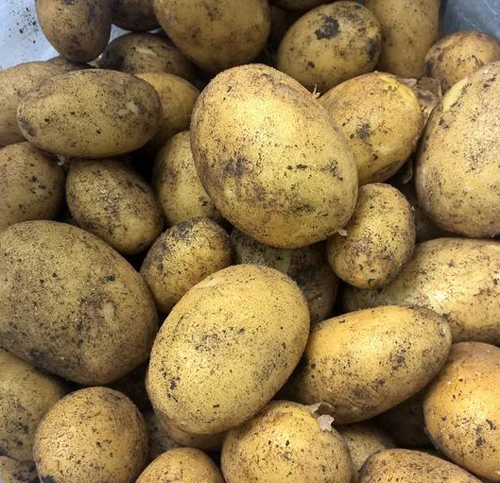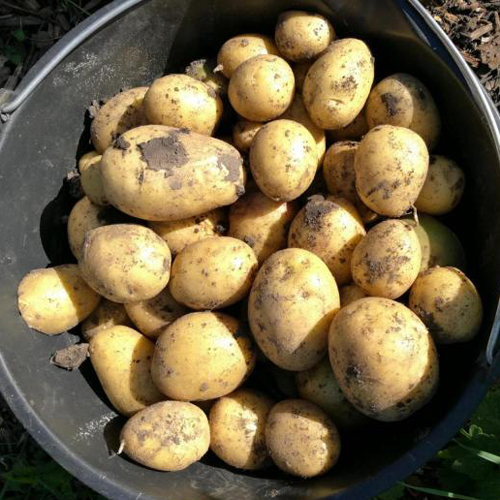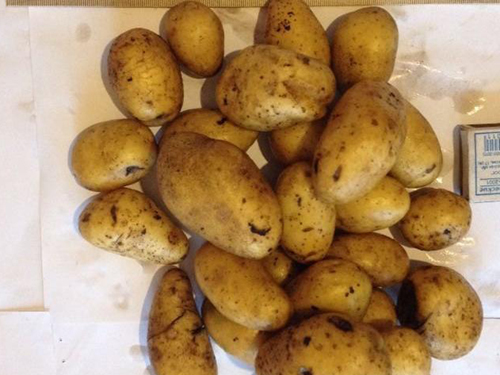Potato variety Colette
Colette is a German early maturing potato variety (Solanum tuberosum) for universal use. It was bred in the late 90s by the specialists of the Kartoffelzucht Bohm company in cooperation with EUROPLANT Pflanzenzucht GmbH. In 2002 he was included in the state register of breeding achievements of the Russian Federation. Zoned in three regions of the country: Central, Volgo-Vyatka, North Caucasian. One of the most commonly used varieties for processing into chips. Differs in high marketability of tubers, good keeping quality. Can produce two crops per season.

It is worth noting one nuance for a start. Some gardeners call our hero "Limonka", but this is not entirely correct. The fact is that "lemon" is the popular nickname for most varieties of potatoes with a bright yellow skin. Some sources, however, report the existence of a separate species with this name, but there is no official data on its reality. With the same success they nicknamed the lemon and Picasso, Vinet, Jelly and etc.
The period from the moment of emergence of full shoots to harvest is 50-65 days. The first digging can be carried out on the 45th day of the growing season.
The plant is of medium height, semi-erect. Leaves are medium in size, light green, with slightly wavy edges. The flowers are rather large, the corolla is red-violet in color. Flowering at Colette is short-lived and scarce.
In one nest, an average of about 6-11 marketable homogeneous tubers weighing 66-125 grams are formed. They have an oval oblong regular shape and a smooth surface. The rind is thin, yellow, very smooth to the touch. The pulp is light yellow in color. The eyes are shallow, the depth is shallow, so they are practically invisible. The tubers in the nest are clustered together and are formed close to the surface, making it very convenient to dig in them.
The marketable yield of potatoes, according to state tests, is 166-217 c / ha, at the level of standards Zhukovsky and 43 kg / ha more than Bryansk early. On the 45th day after germination (at the first digging), it was possible to collect 113-153 c / ha, at the level and by 52 c / ha more than the standard of the Bryansky Early variety. During the second digging, on the 55th day of the growing season, 156-276 kg / ha were obtained from one hectare, at the level and 39 kg / ha higher than the established standards. The maximum yield was achieved in the Rostov region - 290 c / ha. According to some reports, with proper agricultural technology, it is possible to collect up to 600 c / ha. The marketability of tubers is 76-98%, keeping quality is 92%, the tendency to germination is low.

Colette tastes very good. The digestibility of the tubers is average, which makes them versatile in cooking. After heat treatment, they retain their color and shape, look attractive and appetizing. The main area of application for these potatoes is processing into chips. This variety is preferred by many crispy potato growers! Also tubers are great for deep-frying, and in general, they will perfectly show themselves in absolutely any dish. Unless, they are not particularly suitable for delicate airy puree, but this is already a matter of taste. The pulp contains 12.2-15.2% starch, 1.5-2.7% lower than the standards of Bryansk Early and Volzhanin. But despite this, it has a very pleasant consistency, without excessive wateriness, the dry matter content in it is slightly increased.
The variety is quite demanding on the nutrient and mineral composition of the soil. Colette grows best on loose fertile soils - light loam and sandy loam. However, with proper agricultural technology, it is capable of producing a large amount of yield on soils that are not suitable for it. Plants do not require special attention to themselves, but there are several features of cultivation, which we will talk about below.
- Tubers have a pronounced dormant period, therefore, before planting, they must be warmed up and germinated. Firstly, it will improve the germination rate, and secondly, it will shorten the ripening time of the variety.Be careful when planting germinated seed!
- Experts recommend planting tubers at a distance of 28-30 cm from each other, while the row spacing should be about 75 cm. As for the planting depth, depending on the type of your soil, it can vary. On light soils, the holes can be up to 10 cm deep, while on heavy soils - no more than 6 cm.
- Plants respond well to watering. On well-moistened soils, the yield of Colette increases significantly, so you should take care of the regular supply of water to the potatoes. The ideal solution would be to install an automatic irrigation system.

- Also, the amount of the crop is significantly influenced by the timely implementation of standard agrotechnical measures, such as loosening the soil, weeding, hilling, preventive treatment against pests and diseases. Do not forget about fertilizing the soil. The need for top dressing depends on the composition of your soil. General recommendations are as follows - mineral complexes are introduced in standard amounts, and nitrogen complexes - in limited ones. An excess of nitrogen in the soil leads to an intensification of the growth of green mass to the detriment of the growth of tubers.
- This potato has a rather thin skin, so carelessness in harvesting can lead to dire consequences. Tuber crops with mechanical damage are poorly preserved, moreover, they lose their presentation, and sometimes their taste.
- It is necessary to maintain crop rotation on the site. This will keep your plants from contracting nightshade-like diseases. The most beneficial predecessors will be legumes, cucumber, zucchini, cabbage, garlic, onions, and green manure.
- Renew your seed in a timely manner. This is very important if you want to keep the yield of large marketable tubers at a high level.
Variety Colette is resistant to golden cyst nematode, cancer causative agent, viruses A and Y, common scab, black leg. Shows medium resistance to leaf curling. According to the All-Russian Research Institute of Phytopathology, it is susceptible to late blight in tops and tubers. Incidentally, this is the main disadvantage of the variety.
Over the long period of its existence, this potato has acquired many positive reviews from gardeners and large agricultural enterprises throughout the country. Especially appreciated for its excellent taste, versatility in cooking, as well as suitability for processing into chips. You cannot ignore the excellent presentation of the tubers, their excellent keeping quality. According to the observations of gardeners, tubers can be stored for more than a year, while they do not germinate and retain their consumer qualities and pleasant appearance.

As for the yield, opinions differ here. To some it seems high, to some it is insufficient. Of course, in comparison with some other varieties, our hero may not have an outstanding yield, but he can clearly beat them in his taste! By the way, the difference in opinions on this matter can be explained much easier - with proper agricultural technology and proper care, you, of course, can get more harvest. The growing region also plays an important role in this.
But let's get back to the list of benefits of potatoes. It includes resistance to various diseases, and relative undemanding care, and early amicable ripening of tubers. In addition, Colette can produce two crops per season, but for this you need to take good care of both it and the soil on which it is grown.
Let's not forget to mention the disadvantages of the variety. The main thing is its susceptibility to late blight, however, it is quite simple to solve this problem with the help of preventive treatments and compliance with crop rotation.Otherwise, our hero no longer had any big drawbacks, so it's definitely worth trying to grow him!
Colette is officially cultivated by: ZAO Oktyabrskoe in the Leningrad Region, OOO Alchak in Tatarstan, ZAO Teplichny in the Omsk Region, IP Kolyasin Sergey Nikolaevich in Omsk, OOO Alrost in the Chuvash Republic, OOO Teplichno greenhouse complex "Elite-potato" "in Omsk, LLC" Slavyanka-M "in the Leningrad region. A. G. Lorkha "in the Moscow region., CJSC" Breeding plant "Prinevskoe" "" in the Leningrad region., FGBNU "Udmurt Research Institute of Agriculture" Dawn-new "in the Kaliningrad region. SPK" Agrofirma "Elite potato" "" in the Moscow region., LLC ETK "Meristemnye kultury" in the Stavropol region.









Very small, low yield. They were imprisoned for 2 years, then refused. Volgo-Vyatka region.